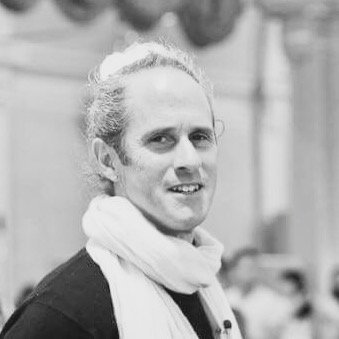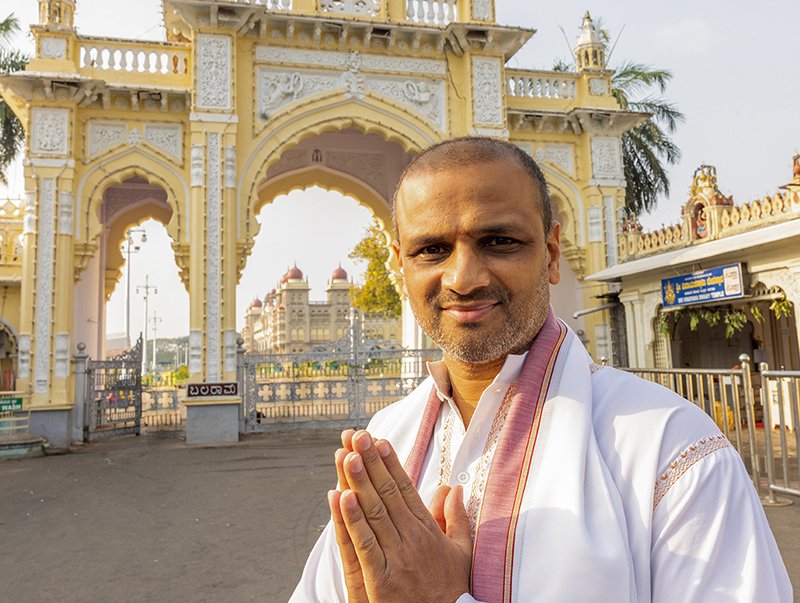This Sunday, July 9, marks Guru Pūrṇimā, the day that students and spiritual seekers pay respects to their gurus, those who are responsible for leading them to the true knowledge of yoga. Guru Pūrṇimā always falls on the full moon day in the Hindu month of Āṣāḍha, which takes place in June and July, according to the lunar calendar. It is also known as Vyāsa Pūrṇimā, the day that honors the ancient sage Veda Vyāsa, the most important guru in India, scribe of the Mahābhārata, and compiler of the ancient Vedas. Another important guru, born on this auspicious day in 1915, and not by chance, is that of the founder of the Aṣṭāṅga yoga tradition, Śrī K Pattabhi Jois.
A yoga guru to thousands of students, Guruji, as Jois was affectionately known, had an enormous impact on how yoga was practiced in India and the rest of the world. His legacy continues to change the face of modern yoga today. From humble beginnings in a small town in South India, he worked tirelessly throughout his life to learn and then spread the authentic method of Aṣṭāṇga yoga. Having been a dedicated student of the great yoga master Tirumalai Krishnamacharya for more than three decades, Guruji had been transformed through practice, study and incredible dedication. His boundless energy and passion for the subject shined brilliantly from within.
Since his passing in 2009, Guruji’s family have continued to teach the Aṣṭāṅga yoga method unchanged. Many students around the world, who have dedicated themselves to years of practice and study with Guruji, Sharath Jois (his grandson) and the Jois family, have also received blessings to teach this method. As students of both Pattabhi and Sharath Jois, many have become a part of this lineage (paramparā) that started with Ramamohan Brahmachari and continued with Sri T. Krishnamacarya, followed by Pattabhi Jois and now Sharath Jois. The unbroken chain of teaching within this paramparā has strengthened the teachings of yoga as we move into the 21st century. Although some minor details may appear to differ between the teachings within this paramparā, those with a deeper perspective understand that the method and inner essence of yoga has remained unchanged.
Related: Sharath Jois on the Importance of Having a Yoga Teacher
Guruji emphasized the importance of following the paramparā, remaining true to the teachings, and above all, continuing to practice unfailingly. One of his major concerns was that yoga was being taught by those without a connection to an authentic lineage or with a proper understanding of the methodology or philosophy of yoga. This was especially true in the West, where yoga was spreading rapidly and many were starting to teach after only short periods of study. Their enthusiasm and passion to share on their newfound love of yoga did not make up for their lack of a real understanding of the teachings.
Honoring Paramparā
While reflecting on the life of Pattabhi Jois on this auspicious Guru Pūrṇimā, it is also poignant to examine the importance of having a guru that is part of an authentic lineage (paramparā). There is no doubt that following paramparā and learning directly from a guru is extremely important for the transmission of a true understanding of yoga. The direct connection from one teacher to the next is what allows the transmission of knowledge that has been accumulated and developed over centuries. It is knowledge that is passed down in a way that cannot be absorbed through books. True knowledge within yoga is an experience of something that is unchanging and permanent, holding true at all times and in all situations.
We could say that this knowledge is itself alive and cannot survive when outside of the human vessel. When paramparā is broken, the essence of the knowledge dies with it. A true guru or teacher must understand both the science and philosophy of yoga and have experienced its benefits firsthand through many years of practice and dedication under the watchful eye of their own guru. It is also this process which brings about the possibility of a transformation within that cannot be quantified empirically.
Understanding the process of yoga requires much insight and clarity and unless there is a guru’s presence to guide the student in the right direction, it is easy to confuse the unreal for the real and the impermanent for the permanent, especially in the early stages of studentship. For a student, it is important that the teachings are received and practiced over a long period of time and with great love and great respect for both their guru and the paramparā. This kind of attitude, found within both the student and the teacher, bring with it receptivity that creates the internal conditions that allow a knowledge of yoga to grow and flourish within. This is perhaps the reason that traditionally, those who are part of a paramparā chant the names of the important gurus within their lineage every morning before beginning their studies and always honor their gurus in prayer.
The Dust of the Guru’s Feet
In India, there is a tradition to touch the feet of the guru and then place the fingers to the eyes. Symbolically, the guru’s feet have become dusty from traveling the path of knowledge. The guru who has traveled the path has a true understanding and is able to pass that knowledge on. The dust ‘opens’ the eyes of the student and reveals the light of knowledge within them.
In the opening Aṣṭāṅga yoga mantra, we begin by chanting “Vande gurūṇāṃ caraṇāravinde,” which translates to “I bow to the lotus feet of the guru.” Here, it should be understand that it is the feet of the guru that we are bowing to, and ultimately, not to the personality or individual, and that the feet represent the knowledge that the guru carries. The guru is a vessel for that knowledge and through many years of practice and study they have hopefully transcended the ego, the sense of ‘I’ and ‘mine,’ enough to be able to transmit the knowledge untainted. When asked about what he was teaching, Pattabhi Jois would say, “This is not my yoga. This is Patāñjali Yoga. This is what my Guru taught me.”
My interactions with Guruji indicated that he was not interested in talking about himself, not interested in the ‘I,’ and unaffected by the turmoil around him. He seemed only interested in enlightening us with the knowledge of yoga. He was, indeed, a true guru to many thousands of students. Since Guruji passed on, his grandson, R. Sharath Jois continues where he left off with many of the same qualities present in his teaching as were in his grandfather’s. In this example of Guruji and Sharath, we see clearly the process of paramparā and transmission of knowledge from the guru to the student. Having spent 20 years practicing and teaching by his grandfather’s side, Sharath has become a guru in his own right continuing to enlighten many thousands of students with the same knowledge taught to him by his grandfather.
Śrī Gurubhyo Namāḥ! May this Guru Pūrṇīma strengthen our connection to the yoga vidya and may we receive the greatest blessing, knowledge, from our guru.








Comments (1)